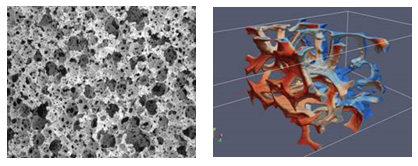Fundamentals of Fluid Flow in Porous Media
Chapter 2
Specific Surface Area
The specific surface of a porous material is defined as the interstitial surface area of the voids and pores either per unit mass (S) or per unit bulk volume (SV) of the porous material (Figure 2‑16). The specific surface based on the solid volume is denoted by SO.

Figure 2-16: Specific Surface Area
For example the specific surface of a porous material made of identical spheres of radius R in a cubic packing is:

It thus becomes obvious that the fine materials will exhibit much greater specific surface than will coarse materials. Some fine porous materials contain an enormous specific area. For example the specific area of sandstone may be in the order of 1500 cm2/cm3. Carman (1938) gives the range of 1.5 x 102 – 2.2 x 102 (1/cm) for specific surface of the sand.
The specific area of a porous material is affected by porosity, by mode of packing, by the grain size and by the shape of the grains. For example disc shaped particles will exhibit a much larger specific area than will spherical ones.
Specific surface plays an important role in a variety of different application of porous media. It is a measure of the adsorption capacity of various industrial adsorbent; it plays an important role in determining the effectiveness of catalysts and filters. In petroleum and rheology study it is related to the fluid conductivity or permeability of porous media.
Obviously the specific surface of natural porous media can be determined only by indirect or statistical methods such as:
Statistical method:
A needle of length “L” is drop at random a great many times on an enlarged photomicrograph of a section of porous material. A count is kept the number of times (α) the pin’s end point falls within the void space and the number of times (β) the pin intersects the perimeter of pores. The specific surface is then found from:

This method is considered one of the best methods. Many other matrix properties can be derived with it.
Adsorption Method:
These are based on the adsorption of a gas or a vapor by solid surface. The solid’s surface area is determined from the quantity of gas adsorbed on it, assuming the gas covers the entire surface of the solid with a uniform monomolecular film.
Fluid Flow:
This method suggests a relation between permeability of a medium and its specific area. Using this relationship one can obtain the specific area by conducting the experiments leading to the determination of the permeability of the medium.
Questions?
If you have any questions at all, please feel free to ask PERM! We are here to help the community.
